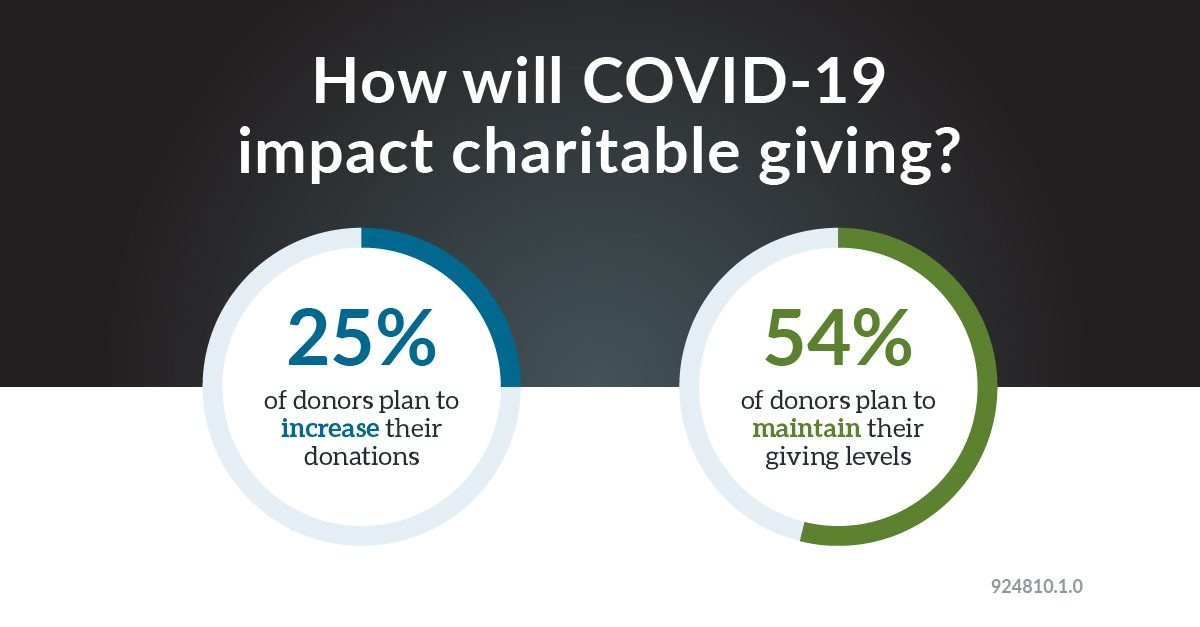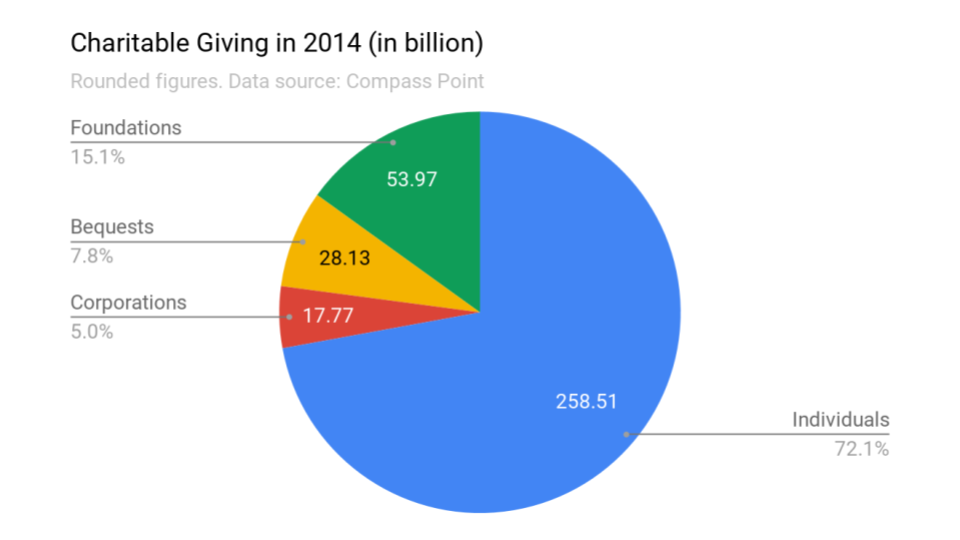Good news for nonprofits drawing up their fundraising plan – Individual and corporate charitable giving increased in 2019.
- Individual giving jumped by 5.1% in 2019 totaling $309.66 billion.
- Corporates, with a 13.4% increase since 2018, gave $21.09 billion to charities.
Even as we struggle with a pandemic this year, giving hasn’t stopped. In fact, by April 2020, individuals and organizations donated $7.8 billion worldwide. And donors plan on maintaining such charitable giving.


What does this mean for your nonprofit?
It means that you need a well thought out fundraising plan and a bunch of fundraising ideas to ensure that the % of donors who plan to increase the donations choose your cause.
That is where this post can help. From knowing how to write a fundraising plan to best practices – we have got you covered.
What should be included in a nonprofit fundraising plan?
Creating a nonprofit fundraising plan includes touching base on:
- A detailed overview of events and strategies
- The amount you aim to raise with each event
- The teams working towards this aim
- Anticipated challenges and ways to overcome them
- Communication strategies
This encompasses a reflection of your past efforts and uses these lessons to spearhead the next round of fundraising.
Here’s how you can bring all this together before your fundraiser begins.
How to write a fundraising plan for your nonprofit in 10 steps.
- Study your past year
- Define your goal for this year
- Set a budget for your expenditure
- Draft a fundraising plan, detailing events and goals
- Include the latest trends of giving and donor outreach
- Establish committees or team
- Strategize communication using messaging, phone banking, social media
- Train your staff and volunteers
- Delegate goals to teams
- Draw a schedule and distribute it among teams
Let’s look at each point in detail.
1. Study your past year
A reflection of the past year in terms of finances and your fundraising efforts’ strengths helps you understand the current situation. It shows you the way forward to minimize damage and efforts and maximize results.
Here’s a fundraising plan template to base your self-assessment on:
| What to look for | What to check |
| The status of your Form 990 | Has the annual reporting form that qualifies you as a federally tax-exempt organization been filed? |
| What was the fundraising goal, and how much did you secure? | If there is a surplus, can it be transferred to this year? If there was a deficit, is the gap calculated in this year’s goals? |
| Who were your pillar donors? | – Major donors – Individual donors – Nonprofit grants – Corporate giving etc |
| Challenges you faced last year | – Do you have a strategy to overcome them this year? – What other challenges do you anticipate this year? |
| What resources did you pay for last time? | Can they be utilized this year too? – Prepaid subscriptions for tools – Electronic/technical equipment – Trained staff |
This study will provide a foundation for your next fundraising action plan. It will show you which direction the fundraiser should follow for maximum impact.
Tip: Your study of the previous fundraising cycle should answer three points:
- What needs to be dumped
- What needs tweaks and alterations to continue
- What can be continued as is
2. Define your goal for this year
Your goal is the epicenter of your fundraising efforts and needs to be clear, concrete, and comprehensive from the very beginning. These goals will be different from the goals you set in the previous cycle and form the foundation of this year’s strategic fundraising plan.
For a comprehensive nonprofit fundraiser plan, you need to set primary objectives like:
- The purpose for this program (what are you raising funds for)
- A solid deadline
- Amount to raise
- Number of donors you aim to retain
- Number of new donors you want to attract
When you finalize these goals, narrow them down into subgoals. For instance,
- How much you expect major donors to give
- How much you’re raising with individual donors.
- Can you depend on nonprofit grants to cover some expenses?
- How does corporate giving fit into these goals?
Tip: Each goal you set (except for the amount to be raised) needs to be ambitious. So even when the results fall short, you achieve your ultimate aim.
3. Set a budget for your expenditure
The 1-10-1000 rule for fundraising is one big event, ten grants, 1000 individual donors. This can be a ratio, depending on how big your organization and your fundraising goal is.
Your budget allocation and division need to be in a way that it accommodates this rule. It is good practice to spend more in areas that have previously worked for you than trying to push failed strategies.
For instance, say digital fundraising has been a better success for you than check-out charities. In such a case, it is more beneficial to dedicate a budget to purchase online fundraising software than to spend money on setting check-out charities in more places.
When you strategize your fundraising action plan, study the biggest givers in your location. A 2014 study showed that the USA’s biggest charitable givers were individuals, and the smallest were corporations.
This means you should probably spend more resources attracting individuals, than on corporate funding (of course, if your past efforts show a different trend, I would recommend following what has previously worked for you)


Related Reading: Unable to Raise Funds? These Fundraising Challenges May Be the Culprit
While finalizing your budget, set aside money for:
- Phone banking and text messaging software
- Events- venue, food and beverages, decoration
- Volunteer/staff allowances
- Stationary
- Paid social media ads
- Creatives
- Miscellaneous expenses
- Admin expenses, salaries, overheads
After setting the limit for such anticipated expenses, distribute the specifics to your team, so they don’t go over-budget.
Tip: As far as possible, do not include future donations as part of your current budget. You can make an exception for grants you are expecting. That is one advantage of nonprofit grants. They add predictability to planning.
4. Draft a fundraising strategy, detailing events and goals
A good fundraising plan involves creating a comprehensive fundraising calendar for the determined period of collecting donations. It consists of a variety of fundraising ideas and strategies to inform and attract different donors.
These strategies are a mix of your previous successes and what is currently trending in the field.
Make sure your fundraising plan outline involves all or some of:
- Online fundraisers
- Events
- Grants
- Text-To-Give
- Telephone Fundraising
- Peer-to-peer fundraising
- Reaching out to major financiers/sponsors
- Corporate giving
- Offline efforts
- Planned giving
- Recurring donations
Additionally, set a promotional strategy to spread the word.
Tip: Here’s a fundraising plan template for you to draft your strategies. All you have to do is answer the following questions:
| Name: Halloween fundraiser | Duration – Sept – Nov 1st. | |||||
| Funds | Amount to be raised | Before this deadline | ||||
| Contacts | Whom to contact | When to contact | Who will contact | |||
| Strategies | For major donations | For medium donations | For small donations | |||
| Target donor | First-time/ repeat donor | Major/minor donor | Individual/ organization | |||
| Dates | Soft launch start/end date | Donor Outreach start/end date | Fundraiser start/end date | |||
| Budget | For communication | For allowances | For stationary |
5. Include the latest trends of giving and donor outreach
It was fair to assume that giving will decline when the pandemic has taken away jobs and savings.
Counterintuitively, it actually increased! This generosity is different in different age-groups, and scrutiny of such trends will help you design an intelligent fundraising plan.
Take the below graph, for instance. The data shows you that more millennials have vowed to increase giving during the pandemic than any other generations.


Creating a fundraising plan for your nonprofit that gives weightage to micro donors and microdonations can help you target these young donors.
Understanding the current direction of how people are giving to charities helps you:
- plan an efficient, strategic fundraising plan
- not miss out on giving sources
Tip: Some points to consider while checking giving trends are
| Trends | Specifics to Consider |
| Demographics of donors | Age-groups, locations (urban/rural), education levels, income levels, type of employment |
| Causes they are giving to | Does your cause resonate directly or indirectly with their current sympathies? |
| Trending donation sizes | Micro-donations, small donations, medium donations, major donations |
| Forms of donations | Events, text-to-give, corporate gift matching, telephone fundraising are some examples |
You May Also Like: 6 Ways to capture and retain young donors for Nonprofits
6. Establish committees or teams
Managing fundraising efforts can get complicated at times. To ensure no work is misplaced or forgotten, the actions need to be minutely planned. Establishing teams ensures this and streamlines developments of your nonprofit fundraising plan.
Some important teams to establish are:
- Accounting
- Communication (internal and external)
- Creatives
- Events
- Management
- Volunteers
Communication and coordination within individual teams and between different teams is crucial when it comes to a long-haul task like raising funds. This communication starts with you. Begin by communicating how every task, team, and member will help the organization go further towards reaching its goal.
Facilitate internal communication at every step of the way. Open interaction within the organization will help staffers and volunteers convey better with your donors.
Tip: Keep digital copies of your fundraising plan. Not only are they easier to share with your teams but also help you:
- Access all information at any time
- Update the progress
- Not digress from the primary goal
- Have all details in place for your next fundraiser
7. Strategize communication using messaging, phone banking, social media
Your fundraising communications plan is the blueprint of how you communicate your appeals to donors– how you do it can make or break your fundraiser. Just like strategies, you need different channels to target different audiences. Popular communication channels for fundraising are:
- Text messaging
- Text-to-donate– This texting tool is fit for supporters and donors who have opted for your text blasts. Mass texting allows you to broadcast your fundraiser’s primary details like cause, amount to be raised, and deadline. You can add a link to your fundraising page and make giving convenient.
- Peer-to-peer texting– Also known as P2P texting, this method allows you to have a one-on-one conversation with supporters. Utilize this tool to converse with previous donors and make donation appeals.
- Phone banking A phone banking tool helps you get in touch with your supporters personally and explain your cause in detail. If your nonprofit fundraising plan focuses on contacting past major donors, phone banking is a great way to show them respect and value. After all, you are asking them to support your cause, and a warm conversation can help in persuasion.
Emails are usually reserved for
- Past donors who have expressed this as the preferred communication mode
- New contacts with whom you haven’t established a rapport yet
Emails allow you to explain your cause in detail and add a direct link to your fundraising page.
Related Reading: Email Vs. Text – Which to Use For Your Nonprofit?
- Social media
The fastest way to spread the word about your fundraiser across geographies- social media can be an affordable, accessible platform for nonprofits.
- Popular sites include Facebook, Instagram, Twitter, and YouTube.
- These platforms allow you to connect with your followers and reach out to other interested parties who haven’t engaged with you previously.
- The use of images, videos, and engaging content like polls or surveys makes your social media donor outreach more intriguing.
- Facebook and Instagram allow grants and privileges to nonprofits to enhance their fundraising efforts. Do check them out.
For tips on how to use them, read our article: Boost Your Fundraising Today with These Social Media Fundraising Tips
- Word of mouth
Your best advertisers are your staff members and volunteers. They have complete faith in the cause and also know your functions inside out. Advertising your nonprofit fundraiser by word of mouth can
- Help with donor outreach
- Increase your visibility online
- Enable fundings via relational organizing
Tip: Encourage your staffers and volunteers to put up your social media posts on their handles, tag their friends, and engage with people personally. This will help you spread the word beyond your immediate supporters.
8. Train your staff and volunteers
As of July 2020, the estimated value of every volunteer hour was $28.54! Needless to say, volunteers are your greatest asset in a fundraising campaign.
Thus, it is essential to spend time and money on training each volunteer in various tasks before delegating their responsibilities. Your volunteer training must include:
- Demos of how texting and phone banking tools operate
- A deep understanding of your cause and fundraising plan
- How to communicate with potential donors
- How to communicate with previous donors
Tip: For fundraising terms that are well over three months, schedule multiple training sessions for staffers and volunteers.
9. Delegate goals to teams
During the training, volunteers and team members will get an idea of each person’s skills, strengths, and interests. Use them to organize your teams. Every team will then have a defined goal to achieve. For instance,
- Collecting x amount from individual donors
- Reaching out to x new leads
- Contacting x old donors
- Securing x grants
Also, don’t forget to organize and include other teams like accounting and management.
Tip: While delegating tasks, clarify the following to team leaders and members:
- Their goals
- The budget they have at their disposal
- Assets/resources they can use
- Deadlines to follow
- Whom to report to
10. Bring it all together
The final step is to weave all your efforts together to draw up a detailed plan for each team. This plan is the one place your staffers and volunteers can refer to in the course of the fundraising efforts.
Team leaders can come together to draw a calendar and schedule tasks before distributing the final timetable to their respective teams. Following are the details the plan should contain:
- Division of the final goal by amount raised and deadlines
- Soft launch of your fundraiser (must include start and end dates, method, and team members involved)
- Communicating the plan to existing staff members and volunteers
- Volunteer outreach
- Budget allocation
- Start and end dates of donor outreach
- Communication method and dates with major donors
- Communication method and date with micro or small donors
- Outreach for new donors
- Regular meetings with team members (schedule them by time or amount raised)
- Events (date, time, nature, team, expected funds)
- Miscellaneous tasks
Tip: Include some space for the donor or volunteer feedback and schedule your strategies to accommodate possible changes.
An excellent nonprofit fundraising plan does not come easy. But it sure makes the work of all team members smooth flowing. Tedious planning is worth the effort.
We hope these comprehensive strategies and templates help you succeed in your fundraising efforts. Check out these 52 proven fundraising ideas you can include in your plan.
Feature image source: Alvaro Reyes/ Unsplash


